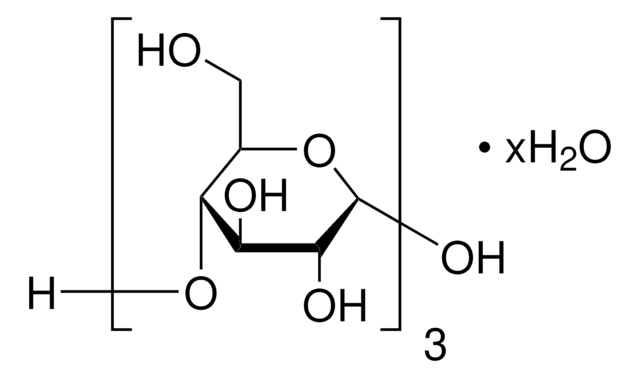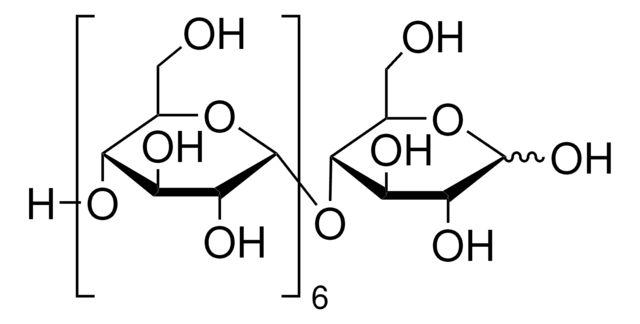M8378
Maltotriose
≥90% (HPLC)
Synonym(s):
α-D-Glc-(1→4)-α-D-Glc-(1→4)-D-Glc, O-α-DD-Glucopyranosyl-(1→4)-O-α-D-glucopyranosyl-(1→4)-D-glucose
About This Item
Recommended Products
biological source
plant
Quality Level
Assay
≥90% (HPLC)
form
powder
color
white
mp
132 -135 °C ((270 - 275 °F ))
solubility
water: 50 mg/mL, clear, colorless
application(s)
agriculture
storage temp.
room temp
SMILES string
[H][C@]1(O)O[C@H](CO)[C@@H](O[C@@]2([H])O[C@H](CO)[C@@H](O[C@@]3([H])O[C@H](CO)[C@@H](O)[C@H](O)[C@H]3O)[C@H](O)[C@H]2O)[C@H](O)[C@H]1O
InChI
1S/C18H32O16/c19-1-4-7(22)8(23)12(27)17(31-4)34-15-6(3-21)32-18(13(28)10(15)25)33-14-5(2-20)30-16(29)11(26)9(14)24/h4-29H,1-3H2/t4-,5-,6-,7-,8+,9-,10-,11-,12-,13-,14-,15-,16+,17-,18-/m1/s1
InChI key
FYGDTMLNYKFZSV-PXXRMHSHSA-N
Looking for similar products? Visit Product Comparison Guide
General description
Application
- as a carbohydrate standard to determine the carbohydrate composition of the wort by high-performance liquid chromatography paired with refractive index detection (HPLC-RID)
- as an acceptor substrate to determine the transglycosylation activity of amylomaltase
- as an acceptor substrate in hydrolytic activity and thermal stability assays
- in a comparative study to investigate the infrared (IR)-Fourier spectra of a carbohydrate series
- in a study to assess the rapid determination of the attenuation limit of beer
- in a study to investigate the influence of fourth-generation poly(propyleneimine) dendrimers on blood cells
Biochem/physiol Actions
Other Notes
Storage Class Code
11 - Combustible Solids
WGK
WGK 3
Flash Point(F)
Not applicable
Flash Point(C)
Not applicable
Personal Protective Equipment
Certificates of Analysis (COA)
Search for Certificates of Analysis (COA) by entering the products Lot/Batch Number. Lot and Batch Numbers can be found on a product’s label following the words ‘Lot’ or ‘Batch’.
Already Own This Product?
Find documentation for the products that you have recently purchased in the Document Library.
Protocols
Separation of Maltotriose; Maltose; Xylitol
Our team of scientists has experience in all areas of research including Life Science, Material Science, Chemical Synthesis, Chromatography, Analytical and many others.
Contact Technical Service







